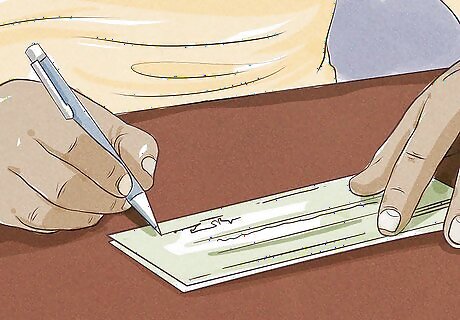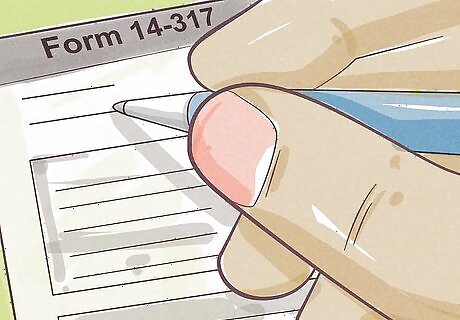
views
Registering after Moving to Texas

Start the process within 30 days of your move. The day you move to Texas is the day that you establish residency. At this point, you have 30 days to complete your vehicle registration.

Get a Texas driver’s license. Apply at a local driving license office. It will cost $25. As long as you have a valid driver’s license from a U.S. state or territory, you will not need to take a written or road test. You will be given a temporary receipt, which you can use to help you register until the official license arrives. Bring your current driver's license, proof of identity (such as a passport or military ID), Social Security Number, and proof of residence (such as a current mortgage statement or a medical card) to the office with you. You will have to surrender your old license. You will receive your new license in the mail within 3 weeks. Licenses from France, South Korea, Taiwan or Germany will also qualify you for a license in Texas. If you have a license from any other country, you will need to take a road knowledge and driving test. You can find your nearest driving license office here: https://www.dmv.org/tx-texas/dmv-office-finder.php.

Update your auto insurance. You will need to get new auto insurance when you move to Texas. Specifically, you are required to have coverage of $30,000 for each injured person, $60,000 for injuries per incident, and $25,000 for property damage. Try calling your old car insurance company to see if they offer policies in Texas. If not, you can use online comparison tools or a local insurance broker to help you find the best deal. Do not cancel your old car insurance policy until you have bought new insurance in Texas. You will receive a new insurance card in the mail, usually within 2 weeks. Keep this handy, as you will need it throughout the registration process.

Get your car inspected at an approved inspection site. All cars are required to undergo a safety inspection, but some counties may also require an emissions inspection. When you take it in, ask for a state inspection. At the end, you will be given an inspection report. A safety inspection will usually cost $7 plus whatever the mechanic charges to do the inspection, but an emissions inspections may cost $31.50. You will be asked to show your auto insurance card when you get your car inspected. You can locate the closest inspection site to you at: http://www.dps.texas.gov/rsd/vi/VIactiveStationLocator/default.aspx

Fill out the Application for Texas Certificate of Title. This is also known as Form 130-U. You may download it at http://www.txdmv.gov/forms. This form can be filled out using a PDF reader on your computer or with a pen. It is also available at your local county tax office. Leave the portion that states “Texas License No” blank. You will need to provide the vehicle identification number, odometer reading, make and model of the car, and standard personal information.

Visit the County Tax Office to register the car. You can find your local county tax office by using the locator tool at http://txdmv.gov/tax-assessor-collectors/county-tax-offices. Make sure to bring with you: Your car insurance card The Vehicle Inspection Report Proof that you own the vehicle, such as the title or registration from your previous state The completed Application for Texas Certificate of Title

Pay the fee. For cars and lighter pickup trucks, the fee is $50.75. It is $30 for mopeds and motorcycles. If your pickup truck is over 6,001 pounds (2,722 kg), you will need to pay $54. You may also need to pay local fees, inspection fees, and processing fees. These can vary from county to county. Local fees can be up to $31.50. The inspection fee is $7.50. This is in addition to what you paid the inspection site for the inspection. The processing fee is about $4.75. It will cover the cost of your plate and registration sticker. You may be asked to donate to various charities when you register, but these are optional.

Put your new plate and registration sticker on your car. The plate and sticker will arrive in the mail. Remove the old license plate by loosening the screws, and switch it with your new plate. After you screw in the new plate, apply the registration sticker to the upper righthand corner. The license plate and sticker should arrive within 3 weeks. You can track your plate's arrival by going to http://www.txdmv.gov/track.
Renewing Your Registration

Re-register your car before the last day of the month it expires. Car registration must be renewed once a year. Your registration sticker on your license plate will tell you the month and year that the registration expires. This means that the registration is good until the last day of that month. You must renew by that time. You will receive a reminder in the mail to re-register your vehicle. You can also sign up for email reminders by visiting the website.

Undergo an inspection on your car. All counties require a safety inspection, but some also require an emissions inspection. Go to your local inspection site and ask for an annual state inspection. You may be asked to show your insurance card. A safety inspection will usually cost $7 and an emissions inspection may cost $31.50. The mechanic may also charge a fee. You will need to show your auto insurance card when you get your car inspected. You can find a local inspection site at: http://www.dps.texas.gov/rsd/vi/VIactiveStationLocator/default.aspx

Fill out the registration online for a $1.00 discount. Go to https://renew.txdmv.gov/Renew/registrationrenewal/jsp/txdot_reg_ren_enter_vehicle_info.jsp. To login, enter your license plate number and the last 4 digits of your vehicle identification number. Pay the registration fee with a credit card. It will take 3 weeks to get your new stickers. The state will check electronic records from the inspection site to verify that your car has been inspected. The state may be able to verify your insurance electronically. If not, you will be asked to provide information about your auto insurance. This information will be on your insurance card. If you have received a ticket because your registration expired, you cannot register online.

Apply in person at the local county tax office instead. Bring your renewal notice, vehicle inspection report, and insurance card with you. If you didn’t get a renewal notice, bring your license plate number, vehicle identification number, and registration receipt from last year. You will pay by credit or debit card. Cars and light trucks are $50.75. Pickup trucks between 6,001–10,000 pounds (2,722–4,536 kg) are $54. Mopeds and motorcycles are $30. You can find your local county tax office by visiting http://www.txdmv.gov/tax-assessor-collectors/county-tax-offices.

Renew through the mail by paying with a check. The renewal letter will contain a form that you must fill out with your vehicle inspection information. Make a copy of your insurance card. Mail the completed form, copy of the insurance card, and a signed check. Never send the original insurance card. Always make a copy.

Contact the DMV if you are out of state. If you cannot have your car inspected because you are out of state, the DMV may allow you to renew your vehicle without an inspection. You will be required, however, to have the car inspected within 3 days of your return.
Transferring an Old Car to a New Owner

Visit the county tax office if you bought a car from a private seller. You must visit the office with the seller. You will need to bring your auto insurance card and the completed Application for Texas Title (Form 130-U) signed by the seller. The seller must bring a lien release from their car lender (if they owed money on the car) and the most recent Vehicle Inspection Report. The title transfer fee is between $28-33, depending on the county you are registering in. You can search for your closest county tax office by going to http://www.txdmv.gov/tax-assessor-collectors/county-tax-offices.

Complete an additional form and tax if the vehicle was a gift. In addition to the Application for Texas title, you will also need to fill out a form called Affidavit of Motor Vehicle Gift Transfer (or form 14-317). You will pay an extra $10 for the gift tax. Take the forms and the payment to your local county tax office. Both forms are available online at http://www.txdmv.gov/forms.

Visit the county tax office if you got the car in an inheritance or divorce. The process for title transfer can vary based on the circumstances of your divorce or inheritance. Talk to your county tax office for more information. You may still need to pay title transfer fees, typically between $28-33. For example, if your spouse passed away and left no will, you may be asked to fill out an Affidavit of Heirship for a Motor Vehicle (Form VTR-262).
Buying a Car from a Dealer

Watch your mail for a receipt from the dealership. Fortunately, if you bought a brand new car, the dealer will register it for you. They must do this within 20 days of the sale. After this point, the dealer will mail you the receipt and the registration from the tax assessor’s office. If you owe money on the car, you will receive a copy of the original title. If you paid your car off in full, however, you will get the original title itself.

Visit the county tax office if there’s an issue. In most cases, dealerships will handle the registration. If the dealer does not issue a title and registration after roughly 30 days, visit the county tax office with the Manufacturer’s Certificate of Origin and any receipts from the dealer. They will help you identify what went wrong. You can find your local county tax office by going to http://www.txdmv.gov/tax-assessor-collectors/county-tax-offices.

Apply the new license plate to your car when you receive it. You will have temporary plates on your car when you first purchase it. Once your dealer registers the car, you will receive permanent plates. Remove the temporary plates by turning the screws counterclockwise and install your new plates.

Make payments on the car if you owe money. Pay your monthly payments on time. If you miss payments, the dealer can repossess your car at any time. Once you have finished making payments on the car, you will receive the original title in the mail from the dealer.



















Comments
0 comment